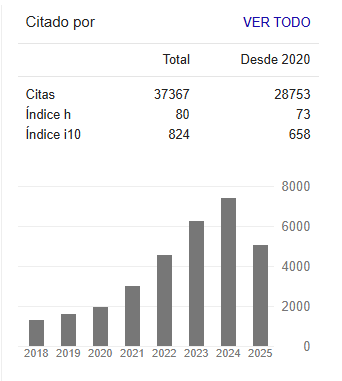Desempeño de las Pymes en México desde una perspectiva de inversión
Abstract
En el mundo actual, la estructura de capital se ha convertido en una herramienta trascendental para el desempeño empresarial. Aunado a ello, las decisiones de inversión estimulan el crecimiento y diversificación empresarial al facilitar la creación de nuevas organizaciones y fomentar los procesos de desarrollo en las organizaciones. El presente análisis teórico-empírico tuvo como propósito analizar la influencia de la estructura de capital en el impacto de las decisiones de inversión de los gerentes en las pequeñas y medianas empresas (Pymes), de Aguascalientes. Se analizaron las diferentes teorías de la estructura de capital mayormente aceptadas, demostrando así, la influencia que tienen las decisiones en el desempeño. Es importante que los gerentes de las Pymes gestionen de una forma adecuada los recursos internos y externos con los que cuenta la organización con la finalidad de lograr un crecimiento sostenible.
References
Aniefor, C. G., Nduka, A. J., Ananwude, A. C., & Ezeaku, C. N. (2021). Effect of Capital Structure on Corporate Performance: Evidence from Agricultural Firms Quoted on the Nigeria Stock Exchange (2007–2018). Journal of Emerging Trends in Management Sciences and Entrepreneurship, 3(1), 68-78.
Azadi, M., Moghaddas, Z., Farzipoor Saen, R., & Hussain, F. K. (2021). Financing manufacturers for investing in Industry 4.0 technologies: internal financing vs. External financing. International Journal of Production Research. https://doi.org/10.1080/00207543.2021.1912431
Aziz, S., & Abbas, U. (2019). Effect of Debt Financing on Firm Performance: A Study on Non-Financial Sector of Pakistan. In Open Journal of Economics and Commerce, 2(1). https://sryahwapublications.com/open-journal-of-economics-and-commerce/pdf/v2-i1/3.pdf
Bagozzi, R. P., & Yi, Y. (1988). On the evaluation of structural equation models. Journal of the Academy of Marketing Science, 16(1), 74–94. https://doi.org/10.1177/009207038801600107
Bandyopadhyay, A., & Barua, N. M. (2016). Factors determining capital structure and corporate performance in India: Studying the business cycle effects. The Quarterly Review of Economics and Finance: Journal of the Midwest Economics Association, 61, 160–172. https://doi.org/10.1016/j.qref.2016.01.004
Bentler, P. M. (2006). EQS 6 Structural Equations Program Manual. Multivariate Software, Inc.
Berger, A. N., & Udell, G. F. (1998). The economics of small business finance: The roles of private equity and debt markets in the financial growth cycle. SSRN Electronic Journal. https://doi.org/10.2139/ssrn.137991
Biger, N., & Mathur, N. A. (2011). The effects of capital structure on profitability: Evidence from United States. International Journal of Management, 28(4). https://www.proquest.com/openview/8c79ee684f821771a04c0fcde84e66e1/1?pq-origsite=gscholar&cbl=5703
Brown, T. A. (2006). Confirmatory Factor Analysis for Applied Research. In D. A. Kenny (Ed.), Methodology in the Social Sciences. The Guilford Press.
Byrne, B. M. (2006). Structural Equation Modeling with EQS, basic concepts, applications, and programming. (2nd ed.). LEA Publishers.
Cassar, G., & Holmes, S. (2003). Capital structure and financing of SMEs: Australian evidence. Accounting and Finance, 43(2), 123–147. https://doi.org/10.1111/1467-629x.t01-1-00085
Cuevas-Vargas, H., Esparza-Durón, M. del R., & González-Acolt, R. (2022). Sustainable marketing orientation and sustainability performance of Mexican small firms. The moderating role of firm age. Procedia Computer Science, 214, 376–383. https://doi.org/10.1016/j.procs.2022.11.188
Cuevas-Vargas, H., Velázquez-Espinoza, N., Cortés-Palacios, H. A., & Ramírez-Razo, M. del S. (2020). Innovación, tecnología y estructura de capital. Un estudio comparativo de las pequeñas empresas mexicanas y colombianas. Ideas Concyteg, 15(256), 17–33.
Detthamrong, U., Chancharat, N., & Vithessonthi, C. (2017). Corporate governance, capital structure and firm performance: Evidence from Thailand. Research in International Business and Finance, 42, 689–709. https://doi.org/10.1016/j.ribaf.2017.07.011
Duc Dat, N. (2022). Impact of Capital Structure on Firm Performance of Food and Beverage Listed Companies on the Stock Exchange of Vietnam. International Journal of Current Science Research and Review, 05(09). https://doi.org/10.47191/ijcsrr/V5-i9-21
Ejem, C. A., & Ogbonna, U. G. (2019). Does M-M proposition on capital structure and firm’s value stand? Evidence from quoted firms in Nigeria. Researchjournali’s Journal of Finance, 7(1), 1–10. https://www.researchgate.net/profile/Chukwu-Ejem/publication/339311721_Does_M-M_Proposition_1_On_Capital_Structure_And_Firm%27s_Value_Stand_Evidence_From_Quoted_Firms%27_In_Nigeria/links/5e4ace69a6fdccd965aed684/Does-M-M-Proposition-1-On-Capital-Structure-And-Firms-Value-Stand-Evidence-From-Quoted-Firms-In-Nigeria.pdf
Melesse, W. E. (2020). Determinants of debt ratio levels among small-scale manufacturing enterprises in Ethiopia: Do government policies matter? https://mpra.ub.uni-muenchen.de/103240/
Ferraro, C. A., & Goldstein, E. (2011). Políticas de acceso al financiamiento para las pequeñas y medianas empresas en América Latina. CEPAL. https://www.cepal.org/es/publicaciones/3909-politicas-acceso-al-financiamiento-pequenas-medianas-empresas-america-latina
Fornell, C., & Larcker, D. F. (1981). Evaluating structural equation models with unobservable variables and measurement error. JMR, Journal of marketing research, 18(1), 39. https://doi.org/10.2307/3151312
Pérez de Lema, D. G., Zuluaga, B. B., & Guijarro, A. M. (2013). Financiación de la innovación en las Mipyme iberoamericanas1. Estudios gerenciales, 29(126), 12–16. https://doi.org/10.1016/s0123-5923(13)70015-9
Gul, S., & Cho, H. R. (2019). Capital structure and default risk: Evidence from Korean stock market. Journal of Asian Finance, Economics and Business, 6(2), 15–24. https://doi.org/10.13106/jafeb.2019.vol6.no2.15
Hair, J. F., Sarstedt, M., Ringle, C. M., & Mena, J. A. (2012). An assessment of the use of partial least squares structural equation modeling in marketing research. Journal of the Academy of Marketing Science, 40(3), 414–433. https://doi.org/10.1007/s11747-011-0261-6
Heyman, D., Deloof, M., & Ooghe, H. (2008). The financial structure of private held Belgian firms. Small Business Economics, 30(3), 301–313. https://doi.org/10.1007/s11187-006-9031-0
Jarallah, S., Saleh, A. S., & Salim, R. (2019). Examining pecking order versus trade-off theories of capital structure: New evidence from Japanese firms. International Journal of Finance and Economics, 24(1), 204–211. https://doi.org/10.1002/ijfe.1657
Jensen, M. C., & Meckling, W. H. (1998). Theory of the firm: Managerial behavior, agency costs and ownership structure. SSRN Electronic Journal, 3, 305–360. https://doi.org/10.2139/ssrn.94043
Kalita, A., & Chepurenko, A. (2020). Competitiveness of Small and Medium Businesses and Competitive Pressure in the Manufacturing Industry. Foresight and STI Governance, 14(2), 36–50. https://doi.org/10.17323/2500-2597.2020.2.36.50
Karacaer, S., Temiz, H., & Gulec, O. F. (2016). Determinants of capital structure: an empirical study of manufacturing firms in India. International Academic Journal of Accounting and Financial Management, 3(2), 47–59.
Kent, H., Kumar, S., & Rao, P. (2020a). Financing preferences and practices of Indian SMEs. Global Finance Journal, 43(100388), 100388. https://doi.org/10.1016/j.gfj.2017.10.003
Kent, H., Kumar, S., & Rao, P. (2020b). Financing preferences and practices of Indian SMEs. Global Finance Journal, 43(100388), 100388. https://doi.org/10.1016/j.gfj.2017.10.003
Krishanthi, D., Abeywardhana, Y., & Abeywardhana, Y. (2017). Financing decision, cost of debt and profitability: evidence from non-financial SMEs in the UK Impact of Capital Structure on Firm Performance: Evidence from Manufacturing Sector SMEs in UK. https://www.researchgate.net/publication/281840519
Kuah, Y. C., Zakaria, Z., & Choong, C. K. (2020). The impact of manager characteristic on capital structure in Malaysian manufacturing SMEs. International Journal of Banking and Finance, 15(1).
Le, T. P. V., & Phan, T. B. N. (2017). Capital structure and firm performance: Empirical evidence from a small transition country. Research in International Business and Finance, 42(July), 710–726. https://doi.org/10.1016/j.ribaf.2017.07.012
Lee, N., Sameen, H., & Cowling, M. (2015). Access to finance for innovative SMEs since the financial crisis. Research Policy, 44(2), 370–380. https://doi.org/10.1016/j.respol.2014.09.008
Margaritis, D., & Psillaki, M. (2010). Capital structure, equity ownership and firm performance. Journal of Banking and Finance, 34(3), 621–632. https://doi.org/10.1016/j.jbankfin.2009.08.023
Modigliani, F., & Miller, M. H. (1958). The Cost of Capital, Corporation Finance and the Theory of Investment. The American Economic Review, 48(3), 261–297.
Myers, S. C. (1977). Determinants of corporate borrowing. Journal of Financial Economics, 5(2), 147–175. https://doi.org/10.1016/0304-405x(77)90015-0
Myers, S. C. (2001). Capital structure. Capital Structure, 15(2), 81–102. https://doi.org/10.4337/9781785363528.00012
Nanda, R., & Rhodes-Kropf, M. (2017). Financing risk and innovation. Management Science, 63(4), 901–918. https://doi.org/http://dx.doi.org/10.1287/mnsc.2015.2350
Nunnally, J. C., & Bernstein, I. H. (1994). Psychometric theory (Third). McGraw-hill education.
Oino, I., & Ukaegbu, B. (2015). The impact of profitability on capital structure and speed of adjustment: An empirical examination of selected firms in Nigerian Stock Exchange. Research in International Business and Finance, 35, 111–121. https://doi.org/10.1016/j.ribaf.2015.03.004
Omondi, M. M., & Muturi, W. (2013). Factors Affecting the Financial Performance of Listed Companies at the Nairobi Securities Exchange in Kenya. In Research Journal of Finance and Accounting, 15(4). https://www.iiste.org/Journals/index.php/RJFA/article/view/8309
Pham, H. S. T., & Nguyen, D. T. (2020a). Debt financing and firm performance: The moderating role of board independence. Journal of General Management, 45(3), 141–151. https://doi.org/10.1177/0306307019886829
Pham, H. S. T., & Nguyen, D. T. (2020b). Debt financing and firm performance: The moderating role of board independence. Journal of General Management, 45(3), 141–151. https://doi.org/10.1177/0306307019886829
Quinn, R. E., & Rohrbaugh, J. (1981). A competing values approach to organizational effectiveness. Public productivity review, 5(2), 122. https://doi.org/10.2307/3380029
Ramli, N. A., Latan, H., & Solovida, G. T. (2019). Determinants of capital structure and firm financial performance—A PLS-SEM approach: Evidence from Malaysia and Indonesia. Quarterly Review of Economics and Finance, 71, 148–160. https://doi.org/10.1016/j.qref.2018.07.001
Stiglitz, J. E. (1974). On the irrelevance of corporate financial policy. American Economic Review, 64(6), 851–866. http://student.bus.olemiss.edu/files/fuller/stiglitz.pdf
Uc Heredia, L. J., García Pérez de Lema, D., & Bastida A., F. J. (2008). Los sistemas de control de gestión y la innovación: Su efecto sobre el rendimiento de las PYMES. Actualidad Contable Faces, 11(17), 135-152. http://www.redalyc.org/articulo.oa?id=25711784012
Umer, U. M. (2013). Determinants of Capital Structure: Empirical Evidence from Large Taxpayer Share Companies in Ethiopia. International Journal of Economics and Finance, 6(1). https://doi.org/10.5539/ijef.v6n1p53
Wu, J., Si, S., & Wu, X. (2016). Entrepreneurial finance and innovation: informal debt as an empirical case. Strategic Entrepreneurship Journal, 10(3), 257–273. https://doi.org/https://doi.org/10.1002/sej.1214
Xin, K., Sun, Y., Zhang, R., & Liu, X. (2019). Debt financing and technological innovation: Evidence from China. Journal of Business Economics and Management, 20(5), 841–859. https://doi.org/10.3846/jbem.2019.10185
Yang, L. R. (2009). Impacts of automation technology on quality of project deliverables in the Taiwanese construction industry. Canadian Journal of Civil Engineering, 36(3), 402–414. https://doi.org/10.1139/L08-072
Yuan, Y., Azam, S., & Tham, J. (2020). Small and medium size enterprises (SMES) in Malaysia: a conceptual underpinning of capital structure decisions and firm performance. European Journal of Social Sciences Studies, 0. doi:http://dx.doi.org/10.46827/ejsss.v0i0.709
Zeitun, R., Temimi, A., & Mimouni, K. (2017). Do financial crises alter the dynamics of corporate capital structure? Evidence from GCC countries. Quarterly Review of Economics and Finance, 63, 21–33. https://doi.org/10.1016/j.qref.2016.05.004
Zhang, L., Zhang, S., & Guo, Y. (2019). The effects of equity financing and debt financing on technological innovation: Evidence from developed countries. Baltic Journal of Management, 14(4), 698–715. https://doi.org/10.1108/BJM-01-2019-0011
Zunckel, S., & Nyide, C. J. (2019). Capital structure of small, medium and micro enterprises: Major factors for a developing economy. Problems and Perspectives in Management, 17(2), 124–133. https://doi.org/10.21511/ppm.17(2).2019.09

This work is licensed under a Creative Commons Attribution-NonCommercial-ShareAlike 4.0 International License.








.png)






























